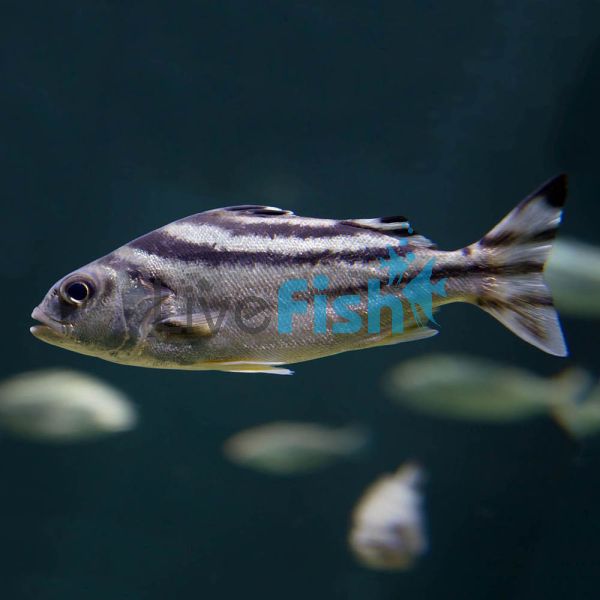Target Fish - Brackish 7cm
The Target Fish, or Terapon jarbua, is an uncommon species that is seen in the aquarium hobby. These are not easily recognizable species and they are a real collectors species to have in a native Australian system. These fish have contrasting colours, reach around 20 cm, and can live in fresh, brackish, and saltwater making them an incredibly versatile species. Brackish water aquariums especially tend to be limited in their stocking options because of availability however this would be a perfect species to have on a larger mangrove-themed system.
Target Fish - Brackish
The Target Fish, or Terapon jarbua, is an uncommon species that is seen in the aquarium hobby. These are not easily recognizable species and they are a real collectors species to have in a native Australian system. These fish have contrasting colours, reach around 20 cm, and can live in fresh, brackish, and saltwater making them an incredibly versatile species. Brackish water aquariums especially tend to be limited in their stocking options because of availability however this would be a perfect species to have on a larger mangrove-themed system.
These target fish have an incredibly vast range commonly found in the estuaries and coastal waters of the Indo-Pacific region, including Southeast Asia, India, and Australia. The target fish has a very contrasting array of colours especially when they are juveniles. The body is a metallic chrome colour which reflects light amazingly against the small silver scales, this silver can also have hints of grey and olive green mixed in. Starting from just above the eye, the target fish has a set of three curved stripes that link up to the tail and dorsal fins, as juveniles these stripes are jet black but will transition to a golden brown with age. Finally the target fish also have broad and characteristic dorsal fins, when the fish flare this up, it showcases the black spot and dorsal spines.
The breeding habits of this fish are not well-known, but it is known to spawn in freshwater and move to the estuary or marine environment as it matures. It is better to replicate this in the home aquarium as well, adult target fish are not often seen in freshwater and may require the salt as they mature for optimal health. The species does show minimal dimorphism, with males exhibiting brighter colours and more elongated dorsal fins than females.
Tank Recommendations for your Target Fish
Target fish are often found in loose shoals in the wild so it would be recommended to keep them in a group of 3 or more fish. Since they can reach around 25 cm in length, the ideal tank size for these fish would be a 450-liter system. Not only does this easily accommodate the active target fish, but it also ensures there is enough space for other tank mates. These fish are not too concerned with the aquarium setting since they tend to be more of an open water fish however having an aragonite sand substrate with some smooth rocks and caves would be fine. Whilst they are juveniles, plants can also be kept with the target fish but the plants may not survive in higher salinity. The water temperature should be kept between 24-28°C with a pH range of 7.0-8.0.
Suitable Tank Buddies
The target fish is very peaceful and only tends to feed on small crustaceans in the wild. They can be kept with a range of medium-sized aquarium fish fresh, brackish, and saltwater with minimal issues.
Usually Compatible
Spangled perch, jungle perch, archer fish, scats, milkfish, batfish, and other fresh or brackish water-tolerant species.
Sometimes Compatible
Smaller species like pacific blue eyes have a very minimal risk of becoming prey especially when juveniles. Typical freshwater community fish like angelfish might be fine when the target fish is small but as it matures, the target fish will need brackish water.
Rarely Compatible
Neon tetras, shrimp, and other very slow-moving and incredibly small fish. Barramundi, mangrove jack, and other predatory fish will also easily predate on the target fish.
Feeding your Target Fish
In the wild, the Target Fish feeds primarily on small fish and crustaceans. In captivity, they should eat most types of prepared foods, such as flakes, pellets, and frozen or live foods like bloodworms or brine shrimp. Providing a quality community freshwater or marine fish pellet will be a great staple for these fish.
Venomous
No, - Sharp Dorsal spines are a concern of injury.
| Scientific Name | Terapon jarbua |
|---|---|
| Care Level | Moderate |
| Common Names | Target Fish, Cresent Perch, tiger perch |
| Diet | Omnivore |
| Fish Family | Terapontidae |
| Lifespan (years) | 7 |
| Max. Length (cm) | 25 |
| Min. Tank Volume (l) | 450 Liters |
| Origin | Australasia region |
| Reef Safe | Yes |
| Sociability | Peaceful |
| Venomous | No |
| Water Conditions | 22-28° C, pH 7.0-8.0 |




